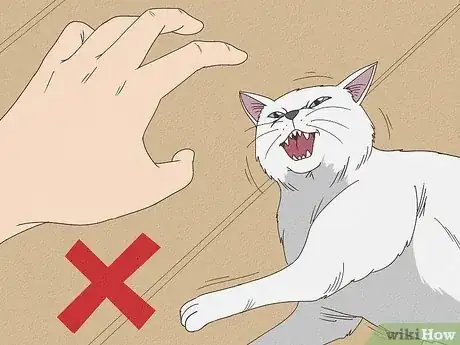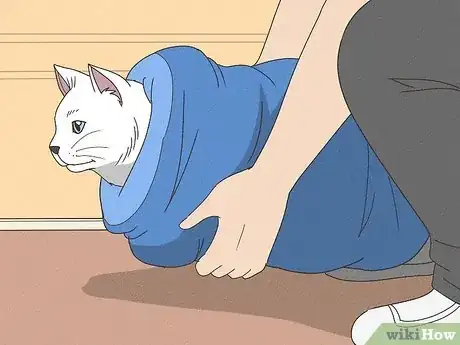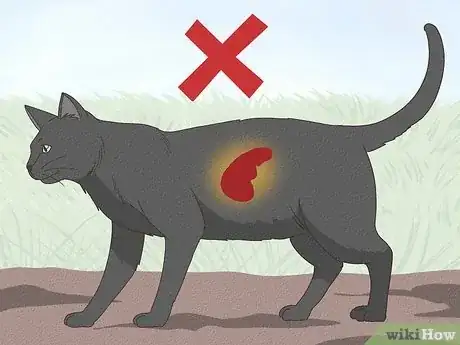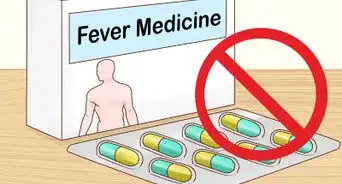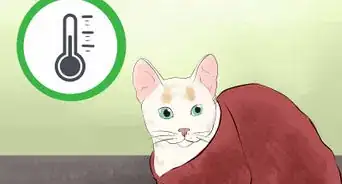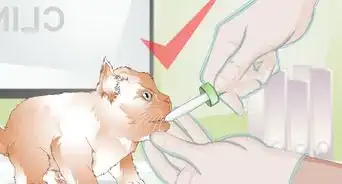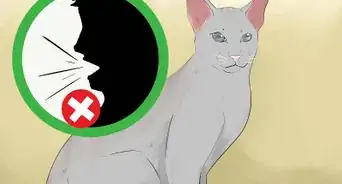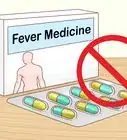X
This article was co-authored by Jean Johnson. Jean Johnson is a Cat Specialist and a writer for the KittyNook Blog. Jean specializes in providing advice on cat health, play, and general information about cats and cat breeds.
This article has been viewed 25,214 times.
Epilepsy is rare in cats, and is a condition where no underlying cause is found to explain the seizures. Luckily, there are ways to control the seizures your cat is experiencing with the help of medication. You can also keep your can safe and happy by protecting him from injury and modifying his lifestyle in certain ways.
Steps
Method 1
Method 1 of 3:
Protecting the Cat from Injury During a Seizure
-
1Move any objects that your cat could knock against while seizing. To decrease the chance of the cat injuring himself during the seizure, look around for objects that he might thrash against. Try to move objects out of the cat's way rather than pick your cat up and remove him from danger.[1] Touching your cat stimulates him, and in his neurologically sensitized state this could worsen the fit or extend its duration.
- For example, if your cat experiences a seizure near a sharp table leg, put a cushion between him and the table to act as padding, rather than picking your cat up.
-
2Avoid touching the cat while he is seizing. A seizuring cat is not conscious of what goes on around him. He lies on his side, his legs paddle and thrash, his jaw chomps, and he may lose control of his bladder and bowels. In this state the cat has no conscious control of his actions and could easily bite or scratch anyone who touches him.[2] The only is exception is if the cat is in danger of falling, which is covered in Step 4 of this section.
- Do not put your fingers near or in his mouth because the cat will bite down and not be able to let go until he recovers consciousness.
Advertisement -
3Eliminate any outside stimulation. Get everyone else to leave the room. It is normal to cry out when witnessing a beloved cat in the grip of a seizure, but this does not help the pet. To reduce the stimulation around your cat:
- Turn off the television or radio.
- Switch off electric lights.
- Close the curtains.
- Avoid the temptation to talk to and soothe the pet. Sadly, this is another form of stimulation and you are likely to do more harm than good, unless he is in danger of falling (which is described in the next step).
-
4Move the cat to a safe location if he is in danger of falling. While you should try to avoid moving or touching your cat during a seizure, the exception is if he is in danger of injuring himself.[3]
- For instance, if your cat has a seizure whilst on a high window ledge use either a duvet cover, or a large, thick towel to cover and then pick up the cat. Doing this will hopefully protect you from accidental bites and scratches.
- With the cat still inside the towel carry him to a safe place, such as a flat, open space, and gently put him down.[4] Make sure his head is uncovered so he can breathe, and then step away.
-
5Contact your vet following the seizure. The average seizure lasts two or three minutes, and your priority during this time should be to keep your cat safe. Once the cat comes round, keep him indoors so that he does not wander off, and phone your veterinarian for further advice.[5] If this is your cat's first seizure he will need to be checked over, and have blood work run to investigate any underlying reason for the seizure.
- It will help your veterinarian to have a full description of the seizure. With this aim, try to note the start and end time of the fit.
- If you have a phone handy, take a video of the fit so that the veterinarian can witness the event first hand.
Advertisement
Method 2
Method 2 of 3:
Controlling Seizures Using Medications
-
1Use phenobarbital to prevent seizures. Most of the anticonvulsants used in dogs are either ineffective, or toxic, to cats. However, phenobarbital has been shown to be effective and safe. The medication works to keep your cat from experiencing seizures.[6]
- Phenobarbital is available as a tablet or syrup, and is generally administered two, or in some cases three, times a day.
- The starting dose of phenobarbital is 1 to 2mg per kg, twice a day. Thus, an average-sized cat requires 1.7 milliliters (0.06 fl oz) of 15 mg/ml phenobarbital elixir twice a day.
- Some cats seem to break phenobarbital down unusually quickly, in which case dosing three times a day is advised.
-
2Give your cat diazepam to prevent seizure clusters. Clusters, or groups of seizures, come about because the first seizure creates a pathway in the brain that makes it easier for another one to follow along behind the first. Diazepam works by slowing down brain activity so that it is less reactive, making it more difficult for the electrical activity associated with a seizure to build.[7]
- After a seizure, the easiest way to administer diazepam is as a rectal suppository, or insertion, where it is rapidly absorbed across your cat’s rectal mucosa. The dose per cat is one 5 mg dosing syringe.
-
3Understand the side effects and risks associated with these medications. The immediate side effects include sedation, and increased appetite and thirst. The sedation should wear off after a few days as your cat’s body acclimatizes to the new medication.
- If the sedation does not wear off in a few days time, call your vet right away.
-
4Do not give these medications to cats with liver conditions. Phenobarbital is deactivated by the liver and should never be given to cats with liver disease. This is because if your cat’s body has a reduced capacity to metabolize phenobarbital, the drug could build up in your cat’s system and become toxic. If your cat is experiencing this, he may seem overly sedated, have difficulty walking, or act like he has been drugged.[8]
- Diazepam is considered controversial because in rare cases the drug can trigger fatal liver failure. This is an idiosyncratic reaction, which is another way of saying scientists haven't got to the bottom of why it happens.
Advertisement
Method 3
Method 3 of 3:
Making Lifestyle Changes
-
1Consider keeping the cat indoors. An epileptic cat that climbs trees or patrols his territory is potentially vulnerable to seizures at inopportune times. If he lost consciousness and fell from a high branch, he could seriously injure himself. In the same way, if he was to become incapacitated during a territory dispute, he would be rendered defenseless. With this in mind it is wiser to keep the cat indoors.
-
2Switch the cat to a gluten-free diet if you think it may help. There is no scientific evidence that diet plays a role in causing epilepsy in the cat. However, there are anecdotal accounts of cats that stopped having seizures when they were fed a gluten free diet. One theory is that anti-gluten antibodies act directly on and are uniquely toxic to the brain. In human medicine, wheat gluten receptors have been shown to trigger opioid receptors in the brain, which in turn triggers seizures.
- Since cats are carnivores it can be argued that they are not equipped to deal with wheat in their diet, and thus more likely to form gluten antibodies. If the cat is otherwise healthy, it would do no harm to put your cat on a complete, balanced diet that is gluten free, low in carbohydrate, and high in protein.
-
3Schedule veterinary appointments for your cat every three months. If your cat experiences seizures and is put on medication, you should consider getting him assessed by a vet more frequently than you would a healthy cat. In particular, it is important that you vet runs blood tests to check and make sure that the liver handling the medication alright.
Advertisement
Community Q&A
-
QuestionWhat do I do if my cat is attacked by another household pet while it is seizing?
 Community AnswerTake any other pets out of the room.
Community AnswerTake any other pets out of the room. -
QuestionWhat if the seizure lasts a long?
 Community AnswerTake the cat to the vet. The longer a seizure lasts, the more likely it is that there will be lasting negative effects.
Community AnswerTake the cat to the vet. The longer a seizure lasts, the more likely it is that there will be lasting negative effects. -
QuestionWhat are the effects of untreated seizures?
 Community AnswerSometimes untreated seizures in cats can lead into permanent brain damage or cause even death. So, you shouldn't delay in getting your cat properly treated.
Community AnswerSometimes untreated seizures in cats can lead into permanent brain damage or cause even death. So, you shouldn't delay in getting your cat properly treated.
Advertisement
Warnings
- In a minority of cases seizures persist despite anticonvulsant medication. The only choice with these cats is to increase the dose of phenobarbital, however, there are some cases that remain refractory to treatment and raising the dose still further risks toxicity.⧼thumbs_response⧽
- If this is the case for your cat, is may be necessary to reach a compromise whereby the cat's seizures are reduced in frequency, and are over more quickly, but not eliminated altogether.⧼thumbs_response⧽
Advertisement
References
- ↑ Jean Johnson. Cat Expert.
- ↑ Manual of Small Animal Neurology. Simon Wheeler. BSAVA Publications.
- ↑ Small Animal Formulary. Ian Ramsey. BSAVA Publications.
- ↑ Jean Johnson. Cat Expert.
- ↑ Jean Johnson. Cat Expert.
- ↑ Manual of Small Animal Neurology. Simon Wheeler. BSAVA Publications.
- ↑ Manual of Small Animal Neurology. Simon Wheeler. BSAVA Publications.
- ↑ Small Animal Formulary. Ian Ramsey. BSAVA Publications.
About This Article
Advertisement

